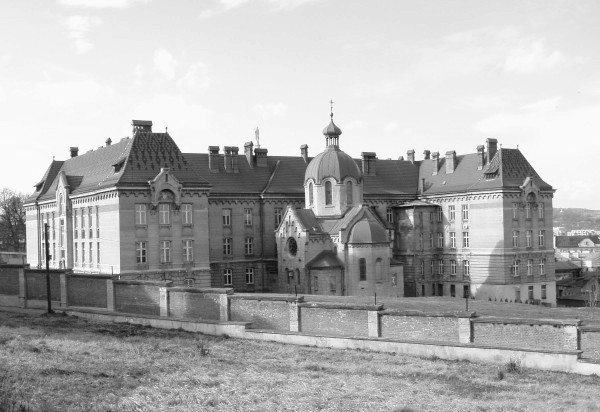Peremyshl eparchy
Peremyshl eparchy [Перемиська епархія; Peremyska eparkhiia]. One of the oldest church administrative districts in Ukraine. The eparchy was established at the latest in the 11th century, and possibly as early as the late 9th or early 10th century. The earliest known bishop was A. Dobrynia Yadreikovych (1218–25). The eparchy initially included all of Galicia and Transcarpathia, until the formation of the separate Halych eparchy (mid-12th century) and Mukachevo eparchy (1491). Occasionally the bishops of Peremyshl have also been known as the bishops of Sambir (from 1422) or Sianik (from the latter half of the 17th century). For this reason the eparchy in the Ukrainian Catholic church is officially known as the ‘unified eparchies of Peremyshl, Sambir, and Sianik.’
Prominent bishops in the 15th and 16th centuries included Y. Biretsky (1467–76), A. Onykii (1498–1521), and A. Radylovsky (1549–81). In 1596 Bishop Mykhail Kopystensky did not support the Church Union of Berestia and remained Orthodox. This action initiated nearly a century of rivalry in the region, with Orthodox and Catholic bishops competing for control over the Peremyshl eparchy. In this period the more prominent Orthodox hierarchs included Isaia Kopynsky and Antin Vynnytsky; Uniate hierarchs included Atanasii Krupetsky, Prokop Khmilevsky (who was never allowed to occupy his see), and I. Malakhovsky. The matter was resolved in 1692, when the Orthodox bishop Inokentii Vynnytsky adopted Catholicism, and the eparchy joined the Uniate church. The Peremyshl eparchy then remained Catholic until 1946. Bishops during that time included Yurii Vynnytsky, O. Shumliansky, Atanasii Sheptytsky, Antin Anhelovych, Maksymiliian Ryllo, Mykhailo Levytsky, Ivan Snihursky, and Yosafat Kotsylovsky. An eparchial seminary functioned briefly in 1780–3 and regularly from 1845 (see Peremyshl Greek Catholic Theological Seminary); it published an eparchial organ (called Vistnyk Peremys’koï eparkhiï [1889–1914] and then Peremys’ki eparkhiial’ni vidomosty [to 1939]), which featured church news, sermons, a church calendar (kalendar), and articles on church history, and copublished the quarterly Dobryi pastyr.
In 1934 a portion of Peremyshl eparchy became part of the separate Lemko Apostolic Administration. This left the eparchy (in 1936) with 578 parishes, 45 deaneries, 695 priests, 8 Basilian men's (with 48 monks) and 8 women's monasteries, 34 residences of the Sisters Servants of Mary Immaculate and 8 of the Sisters of Saint Joseph, and approx 1,131,000 faithful. During the Soviet occupation of Western Ukraine (1939–41) the western part of the Peremyshl eparchy fell under German control and was administered by the auxiliary bishop, Hryhorii Lakota.
After the Second World War the eparchy again was divided, this time between the Ukrainian SSR and Poland. In the eastern portion the Soviet authorities suppressed the Greek Catholic church, and the sham Lviv Sobor of 1946 announced the formal incorporation of the Peremyshl eparchy into the Russian Orthodox church. At the same time Bishops Yosafat Kotsylovsky and Hryhorii Lakota were exiled to Central Asia, where they died in labor camps. Meanwhile, most Ukrainians in the western portion were forcibly resettled by the Polish authorities in the north and west of Poland (see Operation Wisła). The few remaining Ukrainians in the region were forced to switch to either Roman Catholicism or Orthodoxy. After 1957, Ukrainians were again permitted to practice the Eastern rite, and in 1989 the Polish cardinal Józef Glemp consecrated Ivan Martyniak as bishop for Ukrainians, but he was not appointed until January 1991 to the Peremyshl eparchy (see Ukrainian Catholic church).
In 1983 the Polish Autocephalous Orthodox church revived an Orthodox eparchy of Peremyshl–Nowy Sącz, with its see in Sianik, under the Ukrainian bishop A. Dubets. In the late 1980s the Ukrainian Catholic church emerged from the underground in Soviet Ukraine; the territories of the former Peremyshl eparchy within the present-day Ukraine have been incorporated into the revived Lviv archeparchy.
BIBLIOGRAPHY
Skhymatizm vseho klyra rusko-katolicheskoho eparkhiï Peremyshlskoi na hod 1879 (Peremyshl 1879)
Dobrianskii, A. Istoriia episkopov trekh soedinennykh eparkhii, Peremyshl'skoi, Samborskoi i Sanotskoi, ot naidavnyshikh vremen do 1794 (Lviv 1893)
Isaïv, P. Istoriia Peremys'koho iepyskopstva (Philadelphia 1970)
Bendza, M. Prawosławna Diecezja Przemyska w latach 1596–1681 (Warsaw 1982)
Sonevyts'kyi, L. ‘Ukraïns'kyi iepyskopat Peremys'koï i Kholms'koï ieparkhii v XV–XVI st.,’ in his Studiï z istoriï Ukraïny (Paris–New York–Sydney–Toronto 1982)
Wasyl Lencyk
[This article originally appeared in the Encyclopedia of Ukraine, vol. 3 (1993).]
 Old Ukrainian Cathedral.jpg)
 Ukrainian Cathedral.jpg)

